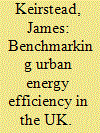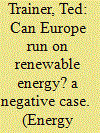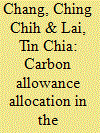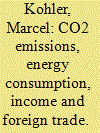|
|
|
Sort Order |
|
|
|
Items / Page
|
|
|
|
|
|
|
| Srl | Item |
| 1 |
ID:
126493


|
|
|
|
|
| Publication |
2013.
|
| Summary/Abstract |
Thermal ratings of overhead lines (OHL) are determined by the current being carried and ambient climatic conditions. Higher temperatures as a result of climate change will give rise to lower ratings, and thus a reduction in current-carrying capacity across the electricity network. Coupled with demand growth and installation of renewable generation on weaker sections of the network, this could necessitate costly reinforcements and upgrades. Previous UK-based work applying a subset of data from the UK Climate Projections model (UKCP09) has indeed indicated likely reductions in the steady-state OHL ratings under worst-case temperature increases. In the present work, time series data from the full UKCP09 probabilistic climate change modelling framework, including an additional algorithm to incorporate hourly wind conditions, is applied to OHL ratings. Rather than focus purely on worst-case conditions, the potential for an increased risk of exceeding nominal ratings values on thermally constrained OHL is analysed. It is shown that whilst there is a small increase in risk under future climate change scenarios, the overall risk remains low. The model further demonstrates that widespread use of real-time dynamic rating systems are likely to represent the most cost-efficient adaptation method for lines which are frequently thermally constrained.
|
|
|
|
|
|
|
|
|
|
|
|
|
|
|
|
| 2 |
ID:
126603


|
|
|
|
|
| Publication |
2013.
|
| Summary/Abstract |
The clean development mechanism (CDM) has been a leading international carbon market and a driving force for sustainable development. But the eruption of controversy over offsets from Chinese wind power in 2009 exposed cracks at the core of how carbon credits are verified in the developing economies. The Chinese wind controversy therefore has direct implications for the design and negotiation of any successor to the Kyoto Protocol or future market-based carbon regimes. In order for carbon markets to avoid controversy and function effectively, the lessons from the Chinese wind controversy should be used to implement key reforms in current and future carbon policy design. The paper examines the application of additionality in the Chinese wind power market and draws implications for the design of effective global carbon offset policy. It demonstrates the causes of the wind power controversy, highlights underlying structural flaws, in how additionality is applied in China, the Offsetters' Paradox, and charts a reform path that can strengthen the credibility of global carbon markets.
|
|
|
|
|
|
|
|
|
|
|
|
|
|
|
|
| 3 |
ID:
126515


|
|
|
|
|
| Publication |
2013.
|
| Summary/Abstract |
During the 2006-2008 period, there were 386 demonstration projects for renewable energy application buildings (REAB) organised by Chinese government, with a total area of approximately 40,420,000 m2. By the end of 2011, the vast majority of these projects had been completed and had passed the final acceptance. This paper analyses the measures taken by the Chinese government, including economic incentive mechanisms, organising agencies, application and evaluation systems, online monitoring platforms, acceptance inspections, assessment systems, standard criteria and so forth. This paper then evaluates the policy effects. The paper shows that there has been a satisfactory effect in the development of the REAB market, mobilising the enthusiasm of the government, equipment manufacturers and scientific research institutions, and promoting energy conservation. In addition, this paper analyses the suitability of different technological types in different climatic zones, which provides further guidance for the development of the REAB. Finally, based on the analyses of the problems met in the implementation of the demonstration projects, this paper proposes some policy suggestions concerning standard criteria, technological development, project management, incentive mechanisms and so on, to promote the development of the REAB more effectively in the future in China.
|
|
|
|
|
|
|
|
|
|
|
|
|
|
|
|
| 4 |
ID:
126568


|
|
|
|
|
| Publication |
2013.
|
| Summary/Abstract |
Despite numerous researchers having investigating the development of wind power, the correlation between the elements influencing wind power development has often been ignored. Hence, this research hopes to incorporate both structural equation model (SEM) and fuzzy cognitive map (FCM) to identify a mutual relationship between the various elements, so as to provide feasible recommendations for management strategies. Initially, SEM is used for identification of correlation between the elements and indicating their direction and strength. A standardized causal coefficient from SEM was then used to create an FCM illustrating the effect of the status of one component on the status of another component. The research results pointed out that "policy" would be the major challenge faced by wind power development, as well as the main cause for other obstructions. Therefore, under the objective of maximizing economic benefits, short-term strategies can adopt suitable measures for the two dimensions of "technology" and "environment"; and while mid-term strategies must consider the indirect influences from "social" dimension, long-term strategies must work on "policy".
|
|
|
|
|
|
|
|
|
|
|
|
|
|
|
|
| 5 |
ID:
126619


|
|
|
|
|
| Publication |
2013.
|
| Summary/Abstract |
The present paper focuses on medium-term effects of alternative windfall management strategies for a resource abundant country where the resource revenues are expected to last over a prolonged period. In particular, the trade-off between spending and saving is analyzed within the framework of a recursive dynamic computable general equilibrium model. The model is further validated against historical data available for 2001-2010. The total factor productivity is calculated endogenously in the model based on a function that reflects the changes in factor productivity.
The results suggest that saving oil revenues, whether in an oil fund or through physical investment in domestic sectors, leads to a higher economic growth. However, physical investment is superior in the short to medium term based on the resultant GDP while creating an oil fund might be more beneficial in the post oil era.
|
|
|
|
|
|
|
|
|
|
|
|
|
|
|
|
| 6 |
ID:
126490


|
|
|
|
|
| Publication |
2013.
|
| Summary/Abstract |
One of the actions proposed to reduce greenhouse gas (GHG) emissions in South Africa (SA) is to install carbon capture and storage (CCS) at new energy-producing plants. This paper aims to evaluate the costs and GHG emissions of implementing CCS at a coal-fired integrated gasification combined cycle (IGCC) power plant, at a coal fired ultra-supercritical (USC) power plant, at a synthetic fuel coal-to-liquid (CTL) plant and at a gas-to-liquid (GTL) plant for SA. The approach for comparing of these CCS applications is based on a combination of a techno-economic analysis with a life-cycle assessment. As expected, the generating costs in plants with CCS are higher than without CCS for all case studies. GHG-abatement costs in 2040 are shown to be the lowest for the IGCC power plant at 173 ZAR07/t CO2eq, followed by the USC power plant at 227 ZAR07/t CO2eq. These costs are considerably higher for the CTL and GTL plants. The results show that from an economic perspective, CCS might be an attractive option for CO2 mitigation in SA especially for the electricity sector. However, a prerequisite for the implementation of CCS is that the technology reaches commercial scale for the investigated options and is socially accepted.
|
|
|
|
|
|
|
|
|
|
|
|
|
|
|
|
| 7 |
ID:
126553


|
|
|
|
|
| Publication |
2013.
|
| Summary/Abstract |
This paper addresses the viability of converting single-family residential buildings in Brazil into zero energy buildings (ZEBs). The European Union and the United States aim ZEBs implementation to address 'peak oil' and environmental concerns. However, literature shows no agreement on a consensual definition of ZEB. Seeking a Brazilian ZEB definition, this paper addresses PassivHaus and thermal comfort standards for hot climates, source metrics for ZEB, Brazil's energy mix, residential energy end uses and Brazilian legal framework for residential photovoltaic (PV) generation. Internal Rate of Return for PV systems in two Brazilian cities is calculated under various scenarios. It shows grid parity was reached from April 2012 to November 2012 assuming residential electric tariffs of that period and the financial conditions given by the Brazilian government for the construction of new dams in the Amazon and the lowest rates offered by Brazilian banks to private individuals. Governmental decision to lower electric residential tariffs in November 2012 reduced the scope of grid parity. Later revocation of a tax exemption in April 2013 ended grid parity in Brazil. It concludes, conversely to developed countries, it is the volatile Brazilian energy policy, instead of economical barriers, the main obstacle for ZEB viability in Brazil.
|
|
|
|
|
|
|
|
|
|
|
|
|
|
|
|
| 8 |
ID:
126572


|
|
|
|
|
| Publication |
2013.
|
| Summary/Abstract |
In many countries, natural resources have been detrimental to the economic development. The literature on "the resource curse" shows a bleak relationship: countries with large natural resources generally experience lower economic growth than other countries. Norway does not fit into this picture. Economic growth has much higher than in most other industrialized countries. This paper describes the key features of the Norwegian management of the petroleum resources. The main focus is on the management of the revenues from the petroleum sector, but the effects of the petroleum sector on the Norwegian economy more generally are also discussed.
|
|
|
|
|
|
|
|
|
|
|
|
|
|
|
|
| 9 |
ID:
126496


|
|
|
|
|
| Publication |
2013.
|
| Summary/Abstract |
There is a lack of synchronization in the expansion of renewable energies and the modernization of the electricity grid infrastructure. Main barriers to grid development are the insufficient regulatory framework, an inefficient allocation of planning and authorization competences and a lack of public acceptance of new grids. As response to these barriers, Germany has implemented a fundamental reform of the planning and authorization of high voltage power lines. We analyze the new regime as to what extent it is able to eliminate existing barriers to grid expansion and thus can serve as model for other countries. We find that the establishment of a single authority competent for planning, authorization and regulation may abolish existing lack of coordination. Also, the implementation of early participation on basis of various consultations phases has been proved to be very successful in the establishment of the first grid development plan. Stricter administrative time-limits and sanctions are likely to have an accelerating effect. And an increased openness to new technologies on basis of pilot project gives grid operators more flexibility in grid development. Recently, the European Commission adopted the German approach in its policy guidelines for other EU members.
|
|
|
|
|
|
|
|
|
|
|
|
|
|
|
|
| 10 |
ID:
126535


|
|
|
|
|
| Publication |
2013.
|
| Summary/Abstract |
This study asks what is the 'best' way to measure urban energy efficiency. There has been recent interest in identifying efficient cities so that best practices can be shared, a process known as benchmarking. Previous studies have used relatively simple metrics that provide limited insight on the complexity of urban energy efficiency and arguably fail to provide a 'fair' measure of urban performance. Using a data set of 198 urban UK local administrative units, three methods are compared: ratio measures, regression residuals, and data envelopment analysis. The results show that each method has its own strengths and weaknesses regarding the ease of interpretation, ability to identify outliers and provide consistent rankings. Efficient areas are diverse but are notably found in low income areas of large conurbations such as London, whereas industrial areas are consistently ranked as inefficient. The results highlight the shortcomings of the underlying production-based energy accounts. Ideally urban energy efficiency benchmarks would be built on consumption-based accounts, but interim recommendations are made regarding the use of efficiency measures that improve upon current practice and facilitate wider conversations about what it means for a specific city to be energy-efficient within an interconnected economy.
|
|
|
|
|
|
|
|
|
|
|
|
|
|
|
|
| 11 |
ID:
126505


|
|
|
|
|
| Publication |
2013.
|
| Summary/Abstract |
The effective delivery of a sustainable energy future raises many challenges in relation to energy distribution where a new understanding of spatial planning is needed in relation to energy production, consumption and storage. Understanding the emergent low carbon energy economy in terms of its production, distribution and consumption characteristics has prompted a deliberate spatial planning interest. This paper examines issues relating to spatial planning, regulation, political legitimacy and accountability in the current and future systems for energy distribution. In particular it examines the Beauly Denny public inquiry in Scotland as a case study in terms of demonstrating the changing state-market-civil relations in an energy transition context with differentiated values and interests. The case study highlights implications for the regulation in the public interest of highly contested spaces, places and development schemes, together with a synopsis of government structure and change that is influencing the future of spatial planning and energy distribution in particular.
|
|
|
|
|
|
|
|
|
|
|
|
|
|
|
|
| 12 |
ID:
126507


|
|
|
|
|
| Publication |
2013.
|
| Summary/Abstract |
This work proposes a technical and economic analysis of the Brazilian matrix energy evaluation, aiming at the evaluation of impacts inherent to technological innovation involved on energy matrix and the sectoral development. Particular attention is given to biomass energy, natural gas, and conventional fuels, considering their impacts on agricultural activity, identifying the highest potential for investment in this sector. As a result, a clear view of the importance of agricultural sector participation in the context of the Brazilian energy is obtained, not only as a consumer, but mainly through self-production energy policy of waste reuse as biomass and of biofuels.
|
|
|
|
|
|
|
|
|
|
|
|
|
|
|
|
| 13 |
ID:
126567


|
|
|
|
|
| Publication |
2013.
|
| Summary/Abstract |
The possibility of 100% renewable supply of European energy is analysed in terms of the amount of redundant plant required to cope with the intermittency of wind and solar energy, and the limited biomass potential. It is concluded that the capital cost would be unaffordable, and that biomass resources are insufficient.
|
|
|
|
|
|
|
|
|
|
|
|
|
|
|
|
| 14 |
ID:
126606


|
|
|
|
|
| Publication |
2013.
|
| Summary/Abstract |
In the public sphere and the literature on climate strategies, the measurability of corporate GHG emissions tends to be taken for granted, and few empirical studies have examined the reliability of such data. The present case study, which was conducted among 10 Canadian companies considered as large final emitters and three auditing firms, focuses on the factors which could affect the perceived credibility of GHG inventories and the strategic implications of these. The qualitative, inductive study allows identifying three main factors which affect trust in business inventories: technical issues and complexity of GHG measurements, lack of transparency on the part of the companies and unreliability of verification mechanisms. The study also makes it possible to evaluate the implications of uncertainties concerning GHG inventories which are of strategic importance for companies and policy makers. While the reliability of GHG measurement is taken for granted at the political level, uncertainties in this area can in fact have a huge impact on the establishment of the cap and trade system. The study also contributes to the literature on carbon accounting by shedding light on underexplored ethical issues, including the lack of independence of auditors and its implications.
|
|
|
|
|
|
|
|
|
|
|
|
|
|
|
|
| 15 |
ID:
126612


|
|
|
|
|
| Publication |
2013.
|
| Summary/Abstract |
This paper presents an analysis of Canadian energy and climate policies in terms of the coherence between federal and provincial/territorial strategies. After briefly describing the institutional, energy, and climate contexts, we perform a SWOT analysis on the themes of energy security, energy efficiency, and technology and innovation. Within this analytical framework, we discuss the coherence of federal and provincial policies and of energy and climate policies. Our analysis shows that there is a lack of consistency in the Canadian energy and climate strategies beyond the application of market principles. Furthermore, in certain sectors, the Canadian approach amounts to an amalgam of decisions made at a provincial level without cooperation with other provinces or with the federal government. One way to improve policy coherence would be to increase the cooperation between the different jurisdictions by using a combination of policy tools and by relying on existing intergovernmental agencies.
|
|
|
|
|
|
|
|
|
|
|
|
|
|
|
|
| 16 |
ID:
126608


|
|
|
|
|
| Publication |
2013.
|
| Summary/Abstract |
This study proposes models for projecting reductions in CO2 emissions of 10%, 20%, 30%, and 40% compared to business as usual (BAU), using a carbon allowance allocation policy and both unimodal and intermodal modes of transportation. The results show that for 10% to 80% decreases in free carbon allowance, the intermodal ratio increased from 1.01% to 53.44%, which led to decreases in carbon emissions and demand ranging from 10.41% to 48.19% and 8.45% to 7.57%, respectively. When free carbon allowances are decreased, the demand for intermodal systems increases accordingly. These results suggest that a carbon allowance allocation policy could mitigate transportation carbon emissions with a relatively small negative impact on economic activity.
|
|
|
|
|
|
|
|
|
|
|
|
|
|
|
|
| 17 |
ID:
126561


|
|
|
|
|
| Publication |
2013.
|
| Summary/Abstract |
This paper presents an analysis of public preferences for a low carbon future UK and compares them with three future scenarios proposed by the UK government based on data from 10,983 self-selected participants who engaged in the UK Department of Energy and Climate Change 'My2050' online simulation. Participants expressed a stronger preference for demand-side options than for supply-side ones. They also chose fuel switching (to electricity) and technical energy efficiency measures above more behaviour focused options. Renewable energy options (wind, solar, marine and hydro) were preferred to other low carbon supply options (nuclear power, carbon capture and storage), with offshore wind power more popular than onshore. Nuclear power was the least popular generation option. Acceptability of the government's three proposed scenarios was tested by comparing these scenarios with the research findings. Greatest support was suggested for the two scenarios emphasising business greenness, home energy efficiency, electrification of home heating and travel behaviour. The lowest level of support was demonstrated for the scenario based on significant growth in nuclear power with minimal increases in energy efficiency. Despite issues regarding the representivity of the sampled respondents, the work demonstrates the possibility of using outputs from the tool to assess publically preferred pathways.
|
|
|
|
|
|
|
|
|
|
|
|
|
|
|
|
| 18 |
ID:
126618


|
|
|
|
|
| Publication |
2013.
|
| Summary/Abstract |
In this paper we empirically investigate the causal link between energy consumption and economic growth employing a Markov switching Granger causality analysis. We carry out our investigation using annual U.S. real GDP, total final energy consumption and total primary energy consumption data which cover the period between 1968 and 2010. We find that there are significant changes in the causal relation between energy consumption and economic growth over the sample period under investigation. Our results show that total final energy consumption and total primary energy consumption have significant predictive content for real economic activity in the U.S. economy. Furthermore, the causality running from energy consumption to output growth seems to be strongly apparent particularly during the periods of economic downturn and energy crisis. We also document that output growth has predictive power in explaining total energy consumption. Furthermore, the power of output growth in predicting total energy consumption is found to diminish after the mid of 1980s.
|
|
|
|
|
|
|
|
|
|
|
|
|
|
|
|
| 19 |
ID:
126494


|
|
|
|
|
| Publication |
2013.
|
| Summary/Abstract |
Nigeria's Biofuels Policy introduced in 2007 mandates a 10% blend (E10) of bioethanol with gasoline. This study investigates the potential for the development of a cellulosic ethanol industry based on the availability of agricultural residues and models the number of commercial processing facilities that could be sited in the six Geo-political zones. The potential for cellulosic ethanol production from agricultural residues in Nigeria is 7556 km3 per annum exceeding the mandate of 10% renewable fuel required and providing the potential for 12 large- and 11 medium-scale processing facilities based on the use of a single feedstock. Cassava and yam peelings provided in excess of 80% of the process residues available with enough feedstock to supply 10 large-scale facilities with a fairly even distribution across the zones. Sorghum straw, millet straw and maize stalks represented 75% of the potential resource available from field residues with the potential to supply 2 large- and 7 medium-scale processing facilities, all of which would be located in the north of the country. When a multi-feedstock approach is used, this provides the potential for either 29 large- or 58 medium-scale facilities based on outputs of 250 and 125 km3 per annum respectively.
|
|
|
|
|
|
|
|
|
|
|
|
|
|
|
|
| 20 |
ID:
126602


|
|
|
|
|
| Publication |
2013.
|
| Summary/Abstract |
The effect of trade liberalisation on environmental conditions has yielded significant debate in the energy economics literature. Although research on the relationship between energy consumption, emissions and economic growth is not new in South Africa, no study specifically addresses the role that South Africa's foreign trade plays in this context. A surprising fact given trade is one of the most important factors that can explain the environmental Kuznets curve. This study employs recent South African trade and energy data and modern econometric techniques to investigate this. The main finding of interest in this paper is the existence of a long run relationship between environmental quality, levels of per capita energy use and foreign trade in South Africa. As anticipated per capita energy use has a significant long run effect in raising the country's CO2 emission levels, yet surprisingly higher levels of trade for the country act to reduce these emissions. Granger causality tests confirm the existence of a positive bidirectional relationship between per capita energy use and CO2 emissions. Whilst the study also finds positive bidirectional causality between trade and income per capita and between trade and per capita energy use, it appears however that trade liberalisation in South Africa has not contributed to a long run growth in pollution-intensive activities nor higher emission levels.
|
|
|
|
|
|
|
|
|
|
|
|
|
|
|
|
|
|
|
|
|